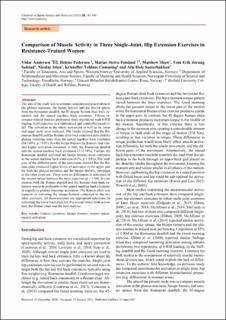| dc.contributor.author | Andersen, Vidar | |
| dc.contributor.author | Pedersen, Helene | |
| dc.contributor.author | Fimland, Marius Steiro | |
| dc.contributor.author | Shaw, Matthew Peter | |
| dc.contributor.author | Solstad, Tom Erik Jorung | |
| dc.contributor.author | Stien, Nicolay | |
| dc.contributor.author | Cumming, Kristoffer Toldnes | |
| dc.contributor.author | Sæterbakken, Atle Hole | |
| dc.date.accessioned | 2021-04-20T10:14:55Z | |
| dc.date.available | 2021-04-20T10:14:55Z | |
| dc.date.created | 2021-04-15T09:11:47Z | |
| dc.date.issued | 2021 | |
| dc.identifier.citation | Journal of Sports Science and Medicine. 2021, 20 181-186. | en_US |
| dc.identifier.issn | 1303-2968 | |
| dc.identifier.uri | https://hdl.handle.net/11250/2738600 | |
| dc.description.abstract | The aim of the study was to compare neuromuscular activation in the gluteus maximus, the biceps femoris and the erector spinae from the Romanian deadlift, the 45-degree Roman chair back extension and the seated machine back extension. Fifteen resistance-trained females performed three repetitions with 6-RM loading in all exercises in a randomized and counterbalanced order. The activation in the whole movement as well as its lower and upper parts were analyzed. The results showed that the Romanian deadlift and the Roman chair back extension activated the gluteus maximus more than the seated machine back extension (94-140%, p < 0.01). For the biceps femoris the Roman chair elicited higher activation compared to both the Romanian deadlift and the seated machine back extension (71-174%). Further, the Romanian deadlift activated the biceps femoris more compared to the seated machine back extension (61%, p < 0.01). The analyses of the different parts of the movement showed that the Roman chair produced higher levels of activation in the upper part for both the gluteus maximus and the biceps femoris, compared to the other exercises. There were no differences in activation of the erector spinae between the three exercises (p = 1.00). In conclusion, both the Roman deadlift and the Roman chair back extension would be preferable to the seated machine back extension in regards to gluteus maximus activation. The Roman chair was superior in activating the biceps femoris compared to the two other exercises. All three exercises are appropriate selections for activating the lower back muscles. For overall lower limb activation, the Roman chair was the best exercise. | en_US |
| dc.language.iso | eng | en_US |
| dc.publisher | Department of Sports Medicine, Uludag University | en_US |
| dc.rights | Attribution-NonCommercial-NoDerivatives 4.0 Internasjonal | * |
| dc.rights.uri | http://creativecommons.org/licenses/by-nc-nd/4.0/deed.no | * |
| dc.title | Comparison of Muscle Activity in Three Single-Joint, Hip Extension Exercises in Resistance-Trained Women | en_US |
| dc.type | Peer reviewed | en_US |
| dc.type | Journal article | en_US |
| dc.description.version | publishedVersion | en_US |
| dc.source.pagenumber | 181-186 | en_US |
| dc.source.volume | 20 | en_US |
| dc.source.journal | Journal of Sports Science and Medicine | en_US |
| dc.identifier.doi | http://dx.doi.org/10.52082/jssm.2021.181 | |
| dc.identifier.cristin | 1904208 | |
| cristin.ispublished | true | |
| cristin.fulltext | original | |
| cristin.qualitycode | 1 | |

